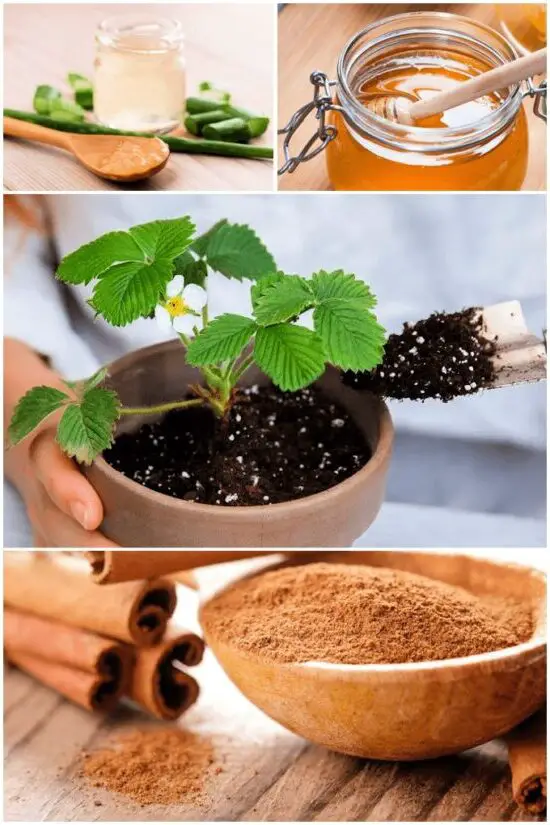Looking to give your plant cuttings a boost? If you’ve been wondering how to make homemade rooting hormone, you’re in luck! By using simple and natural ingredients that you probably already have around the house, you can create your own rooting hormone and help your cuttings establish new roots with ease.
In this article, we’ll explore an easy and effective method for making rooting hormone at home. So, if you’re ready to start rooting those cuttings and watching your plants thrive, keep reading!
How to Make Homemade Rooting Hormone: A Natural Solution for Plant Propagation
Propagation is a fascinating aspect of gardening that allows you to create an abundance of new plants from existing ones.
Whether you want to grow more of your favorite flowers, start a vegetable patch, or simply expand your indoor plant collection, rooting hormone can be a valuable tool in your gardening arsenal.
While commercial rooting hormones are readily available in stores, you can also make your own at home using natural and cost-effective ingredients.
In this article, we’ll guide you through the process of making homemade rooting hormone, explore different types of natural rooting hormones, discuss their benefits, and provide some practical tips for successful plant propagation.
The Importance of Rooting Hormone in Plant Propagation
Before we delve into the details of making homemade rooting hormone, let’s take a moment to understand why it’s beneficial for plant propagation. Rooting hormone, also known as auxin, is a substance that stimulates root growth in plant cuttings.
When a cutting is taken from a parent plant, it lacks the root system required to absorb water and nutrients effectively. By applying rooting hormone to the cutting, you provide it with the necessary boost to develop strong and healthy roots in a shorter period.
Using rooting hormone offers several advantages in plant propagation:
- Increased success rate
Rooting hormone enhances the chances of successful rooting, especially for difficult-to-root plant species or woody cuttings.
- Faster root development
The hormone accelerates root growth, allowing the cutting to establish itself more quickly and improve its chances of survival.
- Healthier plants
By promoting robust root development, rooting hormone helps produce healthier plants with a stronger foundation for growth.
Making Homemade Rooting Hormone
Now that you understand the benefits, let’s explore different methods and examples of homemade rooting hormone recipes using natural ingredients.
1. Cinnamon Powder
Cinnamon is a common household spice that can double as a rooting hormone due to its natural antibacterial and antifungal properties. Follow these steps to create a cinnamon-based rooting hormone:
- Grind a small amount of cinnamon sticks into a fine powder using a mortar and pestle or a grinder.
- Dip the base of the cutting, where the roots will form, into water or aloe vera gel to moisten it.
- Roll the moistened base of the cutting in the cinnamon powder, ensuring an even coating.
- Plant the cutting in a suitable rooting medium and provide it with the appropriate care and conditions for rooting.
2. Honey Solution
Honey contains natural enzymes and sugars that promote root development while helping to prevent infections. Here’s how you can make a honey-based rooting hormone:
- Mix one tablespoon of organic honey with two cups of boiled water.
- Allow the mixture to cool and store it in a clean container.
- Dip the cutting’s base into the honey solution, ensuring it is thoroughly coated.
- Plant the cutting in a rooting medium, such as a mixture of peat moss and perlite, and provide appropriate care for rooting.
3. Willow Water
Willow water is a traditional rooting hormone derived from willow trees and contains natural auxins that promote root growth. Here’s how to prepare it:
- Collect a handful of young willow twigs, preferably from a weeping willow or white willow tree.
- Cut the twigs into small pieces and place them in a pot.
- Add enough water to cover the twigs and bring the mixture to a boil.
- Simmer the mixture for about 30 minutes and allow it to cool overnight.
- Strain the liquid into a clean container, discarding the twigs.
- Soak the cutting’s base in the willow water for a few hours before planting it in a suitable rooting medium.
Tips for Successful Plant Propagation with Rooting Hormone
While homemade rooting hormone can significantly improve your chances of successful plant propagation, there are several additional factors to consider for optimal results. Follow these tips to ensure successful rooting:
1. Choose the Right Plant Cuttings
Not all plant cuttings are suitable for propagation, so it’s essential to choose the right ones. Look for healthy stems that aren’t too young or too old. Softwood cuttings from new growth or semi-hardwood cuttings from partially matured stems often work well.
2. Use the Right Rooting Medium
The rooting medium plays a crucial role in successful plant propagation. Opt for a well-draining medium, such as a mixture of perlite and peat moss or a commercial seed-starting mix. Avoid using garden soil, as it can be too heavy and may harbor pathogens.
3. Provide Optimal Environmental Conditions
To encourage root growth, provide your cuttings with the right environmental conditions. Most cuttings require warm temperatures, indirect light, and high humidity. Covering the cuttings with a plastic bag or using a propagation tray with a clear plastic lid can help create a suitable microclimate.
4. Maintain Proper Moisture Levels
While it’s essential to keep the rooting medium moist, excessive moisture can lead to rotting. Check the moisture levels regularly and water only when necessary. Mist the cuttings with water to maintain humidity if needed.
5. Be Patient and Monitor Progress
Rooting and successful plant propagation take time. Be patient and resist the temptation to disrupt the cuttings or prematurely transplant them. Monitor the progress by gently tugging on the cuttings after a few weeks. If you feel resistance, it indicates that roots are forming.
With these tips and your homemade rooting hormone, you’ll be well on your way to successfully propagating your favorite plants and expanding your garden.
Now that you’ve learned how to make homemade rooting hormone and essential tips for successful plant propagation, you can confidently embark on your gardening journey. Enjoy the gratification of watching your cuttings grow into healthy and thriving plants as you unlock the magic of plant propagation with natural, homemade solutions.
Frequently Asked Questions (FAQs)
Rooting hormone is a substance that is used to stimulate root growth in plants. It is typically applied to plant cuttings to encourage the development of new roots.
Yes, you can make your own homemade rooting hormone using natural ingredients commonly found at home. Here are some methods you can try:
Method 1: Using Willow Water
Willow water contains natural rooting hormones and can be made by soaking willow branches in water. Here’s how:
– Cut fresh willow branches into small pieces.
– Place the willow branches in a container filled with water.
– Let it steep for 24 hours or up to a week.
– Use this homemade rooting hormone by dipping the cut end of the plant cutting into the willow water before planting.
Method 2: Using Honey
Honey can also be used as a rooting hormone due to its antibacterial and antifungal properties. Here’s how to make it:
– Mix 1 tablespoon of honey with 2 cups of boiling water.
– Stir until the honey is dissolved.
– Let the solution cool down before using.
– Dip the cut end of the plant cutting into the honey solution and plant it in a suitable growing medium.
Method 3: Using Aloe Vera Gel
Aloe vera gel contains natural plant hormones that can promote root growth. Here’s how to use it:
– Extract fresh aloe vera gel from an aloe leaf.
– Apply the gel directly to the cut end of the plant cutting.
– Plant the cutting in a suitable growing medium.
Method 4: Using Cinnamon Powder
Cinnamon powder can act as a rooting hormone and also has antifungal properties. Here’s how to use it:
– Dip the cut end of the plant cutting into water to moisten it.
– Roll the moistened end in cinnamon powder to coat it.
– Plant the cutting in a suitable growing medium.
Homemade rooting hormones can be effective in promoting root growth, but their effectiveness may vary depending on the plant species and individual factors. Commercial rooting hormones often provide more consistent and reliable results.
Rooting hormone is typically applied immediately after taking the plant cutting. This allows the hormone to come into direct contact with the cut end, enhancing the chances of successful root development.
The need to dilute homemade rooting hormone solutions depends on the specific method and ingredients used. Follow the instructions provided for each method to ensure proper dilution, if necessary.
Homemade rooting hormone solutions are best used fresh for optimal effectiveness. However, if you have excess solution, you can store it in a sealed container in the refrigerator for a short period.
Final Thoughts
Making homemade rooting hormone is a cost-effective and natural solution to promote successful plant propagation. One simple method involves using willow twigs, which contain a natural hormone called indolebutyric acid (IBA).
To create a homemade rooting hormone, take willow twigs and cut them into small pieces. Boil these pieces in water for about 30 minutes. Let the solution cool and then use it to soak your plant cuttings before planting them in soil. This natural rooting hormone will help stimulate root growth and increase the chances of successful plant propagation.
So, if you’re looking for an affordable and natural way to enhance your plant propagation success, try making homemade rooting hormone using willow twigs.
Auto Amazon Links: No products found.
Perfect Plants Christmas Tree Saver 8oz. | Easy Use Xmas Tree Preserver Food | Have Healthy Green Christmas Trees All Holiday Season
$7.99 (as of December 25, 2025 06:40 GMT +00:00 - More info- Product prices and availability are accurate as of the date/time indicated and are subject to change. Any price and availability information displayed on [relevant Amazon Site(s), as applicable] at the time of purchase will apply to the purchase of this product.
FirEver Pure Christmas Tree Food | Preserver Additive & Season Extender for Live Xmas Trees | Keep It Green, Reduce Needle-Drop | Miracle Freshness (8 oz)
$9.16 (as of December 25, 2025 06:40 GMT +00:00 - More info- Product prices and availability are accurate as of the date/time indicated and are subject to change. Any price and availability information displayed on [relevant Amazon Site(s), as applicable] at the time of purchase will apply to the purchase of this product.
Wilt-Pruf® Christmas Tree/Cutting Preserver Spray |Preserves Christmas Trees, Wreaths, Garlands, Cuttings and Carved Pumpkins | Reduces Needle Drop | Keeps Cut Trees Fresh Longer | Natural (32 oz)
$21.99 (as of December 25, 2025 06:40 GMT +00:00 - More info- Product prices and availability are accurate as of the date/time indicated and are subject to change. Any price and availability information displayed on [relevant Amazon Site(s), as applicable] at the time of purchase will apply to the purchase of this product.
Transmission Funnel - 3'' Wide 23'' Long Funnel with Hose – Flexible, Reusable, No Leak Design Featuring Elastic Long Hose | Long Funnel for Oil, Gas, Coolant, Automotive and Garage Applications
$7.95 (as of December 25, 2025 06:40 GMT +00:00 - More info- Product prices and availability are accurate as of the date/time indicated and are subject to change. Any price and availability information displayed on [relevant Amazon Site(s), as applicable] at the time of purchase will apply to the purchase of this product.
Rocky Mountain Goods Christmas Tree Food - 8 oz Tree Preservative - Reduce Needle Drop - Greener Scent - Fir, Pine, Spruce Trees - Extend Tree Life
$9.95 (as of December 25, 2025 06:40 GMT +00:00 - More info- Product prices and availability are accurate as of the date/time indicated and are subject to change. Any price and availability information displayed on [relevant Amazon Site(s), as applicable] at the time of purchase will apply to the purchase of this product.
Muddy Mat® | Super Absorbent Door Mat Indoor, Microfiber Quick Dry Chenille Entryway Rug, Non-Slip Front Door Mat, Indoor Mats for Entryway, Machine Washable Pet Rug, Grey 30"x19"
$24.95 (as of December 25, 2025 12:41 GMT +00:00 - More info- Product prices and availability are accurate as of the date/time indicated and are subject to change. Any price and availability information displayed on [relevant Amazon Site(s), as applicable] at the time of purchase will apply to the purchase of this product.
OLANLY Dog Door Mat for Muddy Paws 30x20, Absorbs Moisture and Dirt, Absorbent Non-Slip Washable Doormat, Quick Dry Chenille Mud Mat for Dogs, Entry Indoor Entryway Carpet for Inside Floor, Grey
$9.99 (as of December 25, 2025 12:41 GMT +00:00 - More info- Product prices and availability are accurate as of the date/time indicated and are subject to change. Any price and availability information displayed on [relevant Amazon Site(s), as applicable] at the time of purchase will apply to the purchase of this product.
Zevo Flying Insect Trap Official Refill Cartridges - Fits Both Zevo Trap & MAX Indoor Fly Trap - Authentic Trap+Lock Technology to Catch Gnats, House & Fruit Flys (4 Official Refill Cartridges)
$14.97 (as of December 25, 2025 12:41 GMT +00:00 - More info- Product prices and availability are accurate as of the date/time indicated and are subject to change. Any price and availability information displayed on [relevant Amazon Site(s), as applicable] at the time of purchase will apply to the purchase of this product.
TERRO Ant Killer Bait Stations T300B - Liquid Bait to Eliminate Ants - Bait System - 12 Count Stations for Effective Indoor Ant Control
$10.88 (as of December 25, 2025 12:41 GMT +00:00 - More info- Product prices and availability are accurate as of the date/time indicated and are subject to change. Any price and availability information displayed on [relevant Amazon Site(s), as applicable] at the time of purchase will apply to the purchase of this product.
ThermoPro TP50 Digital Hygrometer Indoor Thermometer Room Thermometer and Humidity Gauge with Temperature Humidity Monitor
$11.99 (as of December 25, 2025 12:41 GMT +00:00 - More info- Product prices and availability are accurate as of the date/time indicated and are subject to change. Any price and availability information displayed on [relevant Amazon Site(s), as applicable] at the time of purchase will apply to the purchase of this product.











